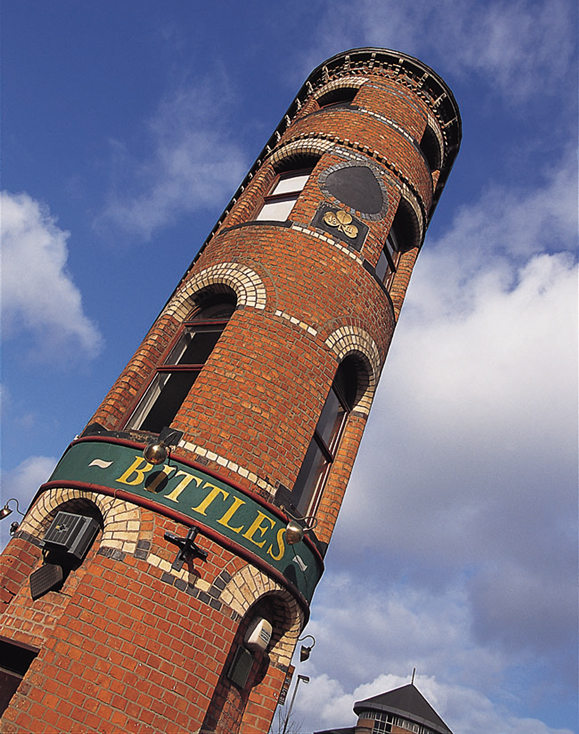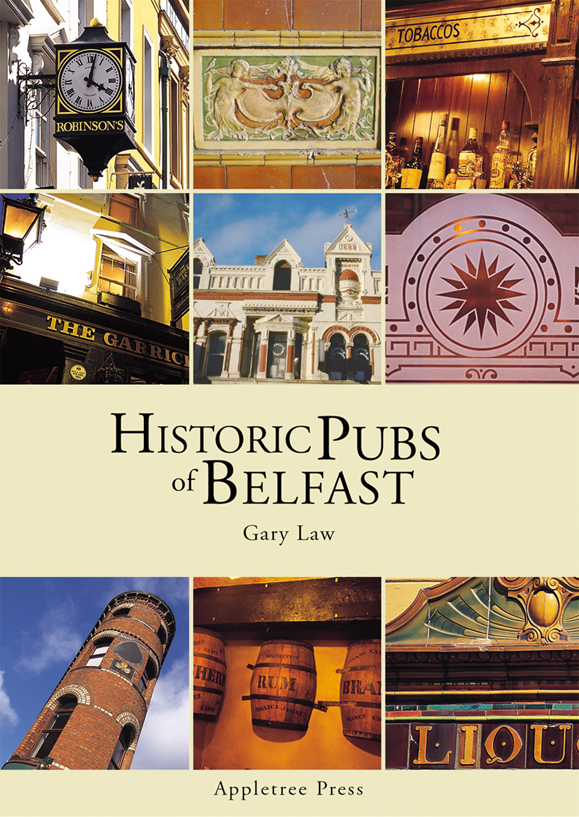Think of Irish pubs and the mind turns to Dublin; sipping a pint of Guinness as the sun streams over the aged wooden interiors of Doheny and Nesbitt’s or following the literary trail of Joyce, Behan and Kavanagh through Davy Byrne’s, Mulligans and McDaids. Celebrated in verse and novel, a focal point for every tourist, Dublin pub culture is a treasure to be prized. But travel 100 miles north, and it’s a very different story. When I first visited Belfast, the apparent absence of an equivalent pub heritage was one of the first things I noticed. It took several more visits, and some helpful advice, before one by one, I discovered its hidden gems. I just wish Historic Pubs of Belfast by Belfast journalist Gary Law, remarkably the first book to cover the great Belfast pubs, extinct and extant, had been available a little earlier.
Nearly every visitor to Belfast has downed a pint of stout at the Crown Liquor Saloon, probably the world’s most beautiful Victorian pub, but ask them to name another great Belfast drinking institution and that is almost certainly where the conversation ends. But then they had an excuse not to know about Bittles, Pat’s Bar, The Rotterdam, The Kitchen Bar, White’s Tavern, McHugh’s, the Morning Star, Hatfield House and the Sir John Hewitt and many others. Not any more. Law’s book is certainly timely, because there is nothing like a real Belfast pub to reveal the true character of a people and city whose warmth and humor have been overshadowed by the events of the last thirty years or so.
Indeed, as the introduction to the book makes clear, between the Blitz, the Troubles and the rampant development of recent times, not to mention the influence of a very militant teetotal movement, it’s a wonder Belfast — which once teemed with pubs — has any historic examples left at all. It is a little sad, it must be said, to read about the fascinating pubs that haven’t lasted the distance. These include Belfast’s first ever, The Sir Moses Cellars, which survived over two hundred years from the beginning of the 17th century, and Molly Ward’s Tavern by the Lagan lock-gates, a favorite meeting place for United Irishmen such as Wolfe Tone and Henry Joy McCracken. In fact, Molly lost her license after being suspected of hiding arms and gunpowder for the revolutionaries.
It is, it must be admitted, a largely male history, as, until the middle of the last century, women were rarely to be found in most Belfast pubs, hence the introduction of snugs, which shielded the few women brave enough to venture out for a drink, as well as protecting the upper classes from the common herd. In the 1960s and 1970s, the Blouse Bar was one of the only pubs in Ireland to have a ladies-own lounge.

Thankfully, the book has more than its share of still thriving pubs, marked, aptly, with a pint of Guinness next to their name. You can, incidentally, always spot a historic pub in Belfast, they are nearly always on a street corner and take their address not from the main road but from the side street so they can be easily identified. Where to start your tour? Why not Bittles Bar, in one of Ireland’s most striking buildings. Due to the haphazard layout of Belfast streets, some extremely odd shaped buildings were constructed to fill the cramped spaces. The triangular red brick Abercorn Buildings, which looks a little like an inhabited chimney and houses the literary-themed Bittles, is certainly one of the oddest.
My own favorites include the Victorian Kitchen Bar, now hanging limpet-like to the edge of a modern office block and sadly, whose existence is now threatened by further development. Once the haunt of music hall stars, whose pictures adorn the walls, it has been a Belfast institution since 1880. Try a Paddy’s Pizza (pizza topping on soda bread), a pint of real ale, enjoy superb live traditional music and absorb, while you still can, the unchanged atmosphere of old Belfast. Or, down at the docks, over cobbled streets still lined with rail tracks, The Rotterdam, at least 130 years old, probably much longer, which, like nearby Pat’s, served the men who built the Titanic and many other great liners when the Belfast docks still hummed. It’s been beautifully restored too, as the book reveals. “We wanted to create a bar that was rough at the edges but full of character” claimed the owners at the time. They succeeded and now the pub is also a Mecca for blues, folk, Irish and jazz music fans.
The Morning Star, which now serves some of the best food in Belfast (including crocodile and kangaroo steak!), down the narrow Pottinger’s Entry, is another beautiful example of a true Belfast pub, immediately recognizable by its fine glass and wrought iron sign and with a bar that dates from 1925. The oldest continuing serving pub is Kelly’s Cellars, where Henry Joy McCracken once hid under the bar counter, and whose “vaulted interior” as the book puts it, “still retains more than a whiff of its long and colorful past.” McHugh’s, housed in arguably Belfast’s oldest building and owned by Belfast pub entrepreneur Jas Mooney (who also owns the Rotterdam), cost a staggering £1 million to renovate. The original face has been largely retained as well as a listed staircase and exposed brick walls inside. Mooney’s idea was to create a pub museum devoted to a history of the area. It shouldn’t be missed. Nor, if you really love great Irish pubs, should this book. ♦


Did the Farry family owned The morning star bar 1972 thanks